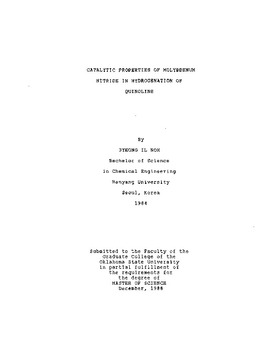| dc.contributor.advisor | Seapan, Mayis | |
| dc.contributor.author | Noh, Byeong Il | |
| dc.date.accessioned | 2015-08-19T16:06:27Z | |
| dc.date.available | 2015-08-19T16:06:27Z | |
| dc.date.issued | 1988-12-01 | |
| dc.identifier.uri | https://hdl.handle.net/11244/15680 | |
| dc.description.abstract | Improved methods for hydrodenitrogenation of fuels will become of greater importance in the future as it becomes necessary to rely increasingly on processing of lower grade petroleum and liquids derived from coal and oil shale. Model compound studies of various heterocyclic nitrogen compounds have shown that hydrodenitrogenation proceeds via saturation of the heterocyclic ring, followed by hydrogenolysis of C-N bonds. These reactions consume more hydrogen than hydrodesulfurization reactions which do not need any ring saturation over the same catalysts. In this study, the performance of an unsupported molybdenum nitride powder has been investigated for the hydrogenation of quinoline in a batch reactor at 10.4 MPa (1500 psig) and 270 to 330 oc. 3-5 g of the catalyst was added to a mixture of 10 wt.% quinoline in n-hexadecane and the products were compared with those from noncatalytic reactions. The unique hydrocarbon product of both catalytic and noncatalytic reactions was identified as 1,2,3,4 - tetrahydroquinoline. This confirmed the specific selectivity of molybdenum nitride catalyst and that only the pyridine side of quinoline adsorbed on the surface of catalyst. However, it was found that the catalyst has very low activity at the reaction conditions, compared with that of a presulfided commercial HDN catalyst. The kinetics of hydrogenation of quinoline have been studied by the first order reversible reaction model and the rate constants and the activation energies were calculated. The rate constants at 270, 300, and 330 oc are 0.00262, 0.0124, 0.0394 (1 I g cat. hr), respectively which result in an activation energy of 165 kJ/mol (39.4 kcal/mol). These rate constants were compared with those of the reaction over sulfided catalysts in order to evaluate the catalytic activity of the molybdenum nitride. Catalyst characterization studies showed that the physical stzucture of the catalyst changed during the reaction, resulting in an increase in the surface area. | |
| dc.format | application/pdf | |
| dc.language | en_US | |
| dc.publisher | Oklahoma State University | |
| dc.rights | Copyright is held by the author who has granted the Oklahoma State University Library the non-exclusive right to share this material in its institutional repository. Contact Digital Library Services at lib-dls@okstate.edu or 405-744-9161 for the permission policy on the use, reproduction or distribution of this material. | |
| dc.title | Catalytic Properties of Molybdenum Nitride in Hydrogenation of Quinoline | |
| dc.type | text | |
| dc.contributor.committeeMember | Johannes, Arland H. | |
| dc.contributor.committeeMember | Foutch, Gary Lynn | |
| osu.filename | Thesis-1988-N779c.pdf | |
| osu.accesstype | Open Access | |
| dc.description.department | Chemical Engineering | |
| dc.type.genre | Thesis | |
